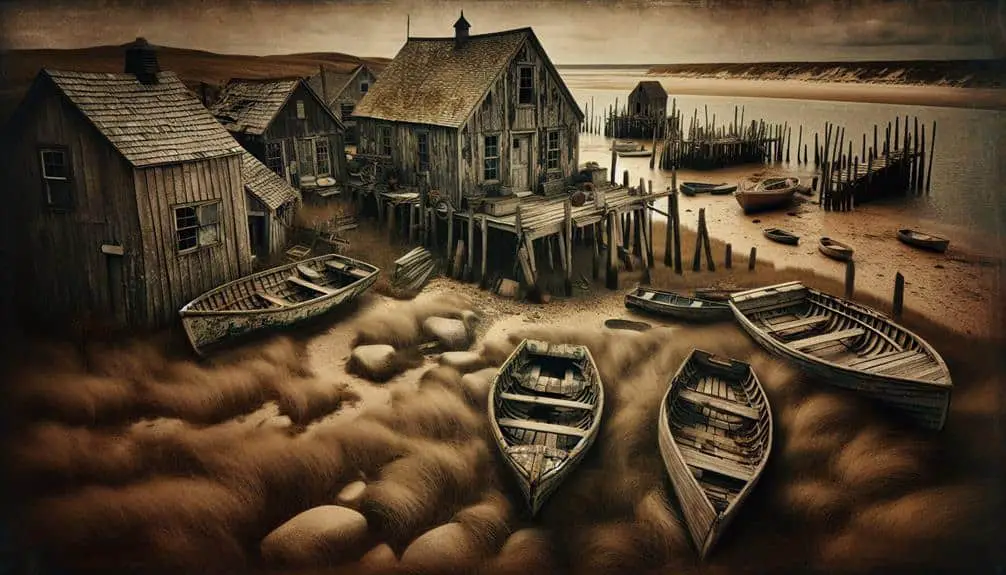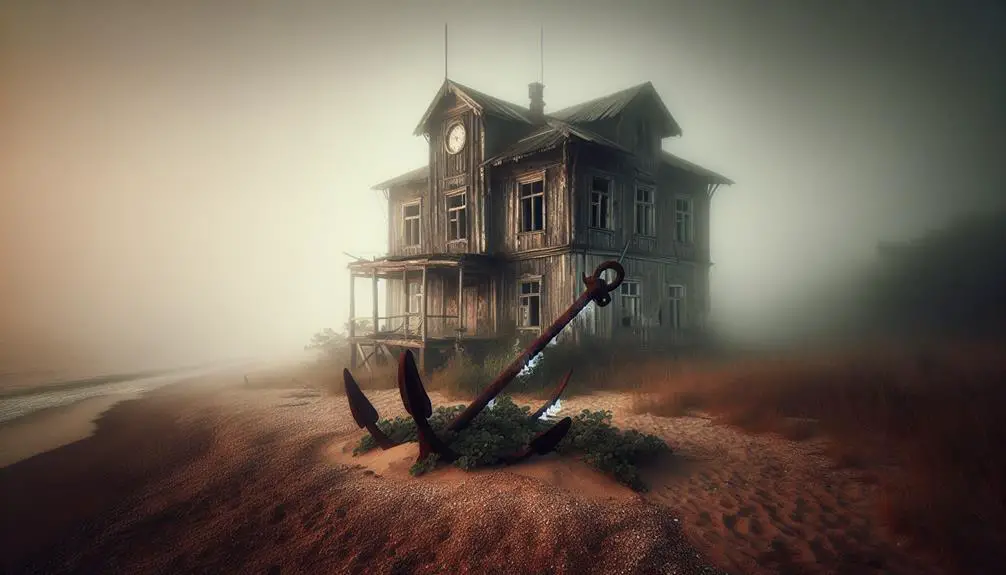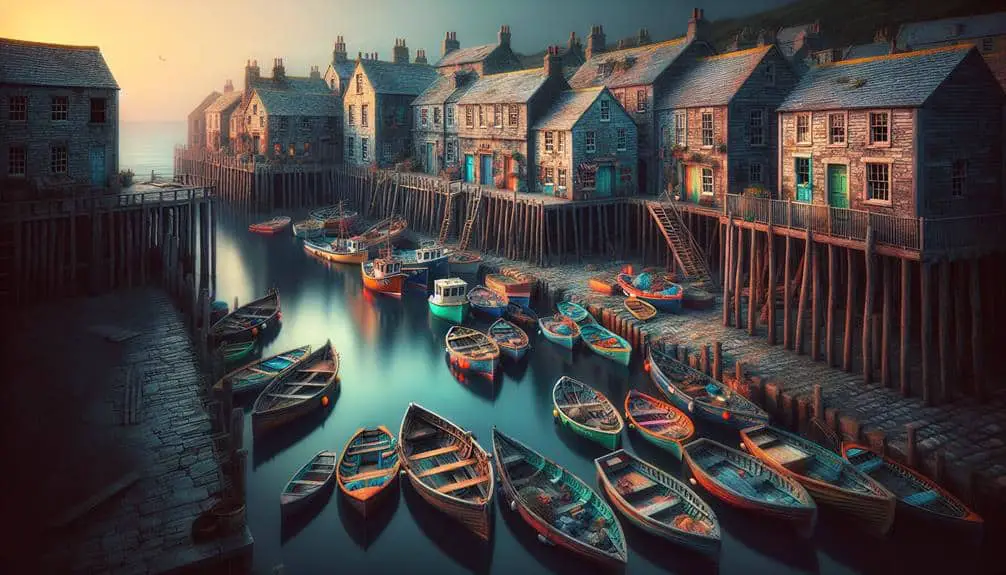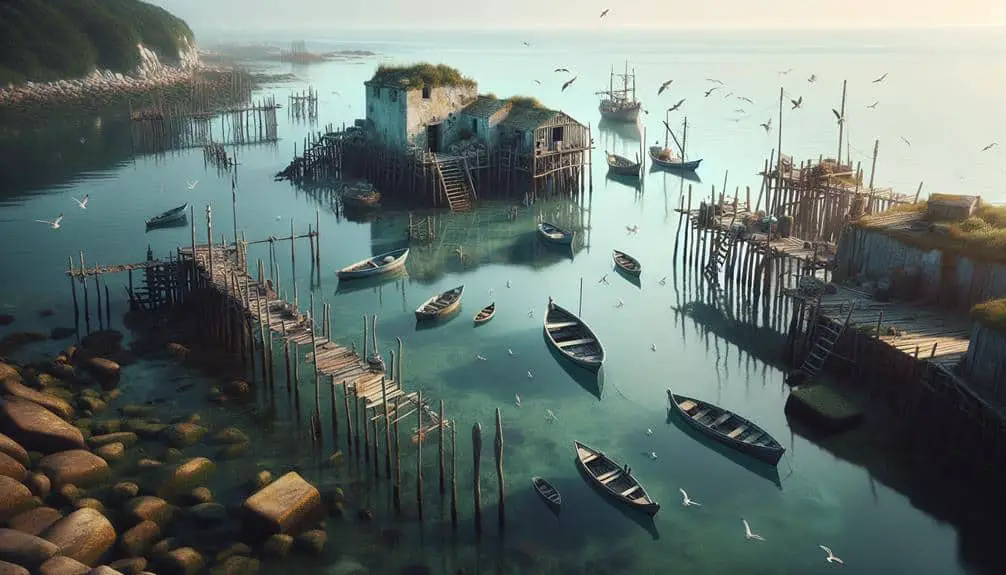Step into the forgotten coastal fishing villages of America. Maine's Lobstering Outpost, once bustling, now deserted due to coastal erosion, offers a sense of freedom by the vast ocean. Georgia's Shrimp Village, with decaying boats, tells a tale of revival efforts and brighter futures. California's Whaling Station echoes whispers of adventure and economic impact. Each village showcases the resilience and beauty of the communities intertwined with the sea. Discover these tales of resilience and the enduring spirit of the sea. More awaits in these abandoned coastal fishing villages across America.
Key Points
- Maine's deserted lobstering outpost due to coastal erosion.
- Historic shrimp village in Georgia with abandoned fishing boats.
- Desolate remains of a once-thriving fishing community.
- Abandoned whaling station in California with preservation efforts.
- Lost salmon fishing village in Alaska with decaying fish processing stations.
Maines Deserted Lobstering Outpost
Nestled along Maine's rugged coast, the once bustling lobstering outpost now stands eerily deserted, echoing with the whispers of a bygone era. The lobstering traditions that once flourished here are now just memories carried by the salty breeze that sweeps through the abandoned docks. The impact of coastal erosion has been harsh, mercilessly claiming the land where generations of fishermen once cast their nets. The relentless waves have gnawed at the shoreline, slowly erasing the footprints of those who depended on the sea for their livelihood.
As you walk through the empty village, you can almost hear the laughter of families sharing stories after a day out at sea. The colorful buoys lay scattered on the pebbled beach, a stark contrast to the desolation that now reigns. Nature's power is evident in the crumbling buildings and the skeletal remains of what was once a thriving community. Despite the emptiness that envelopes this place, there's a sense of freedom in the vast expanse of the ocean stretching out before you, a reminder of the resilience of those who once called this place home.
Forgotten Shrimp Village in Georgia
As you wander through the forgotten shrimp village in Georgia, you can almost hear the echoes of bustling docks and the chatter of fishermen unloading their catch.
The historic shrimp industry that once thrived here now lies in ruins, with desolate coastal remains whispering tales of a bygone era.
Abandoned fishing boats bobbing gently in the water serve as solemn reminders of the village's past glory.
Historic Shrimp Industry
In the heart of coastal Georgia lies a forgotten shrimp village that once thrived on the historic shrimp industry. Once bustling with fishermen and shrimp boats, this village witnessed the rise and fall of the shrimp industry.
As the shrimp industry declined, so did the livelihood of the villagers. The once vibrant community began to fade away, leaving behind empty docks and abandoned homes.
However, in recent years, there have been efforts towards coastal community revival. Local organizations are working to breathe new life into this forgotten village, hoping to restore its former glory. The resilience of the villagers and the beauty of the coastal landscape create a sense of optimism for a brighter future ahead.
Desolate Coastal Remains
The echoes of a bygone era linger in the desolate coastal remains of the once-thriving shrimp village in Georgia, where the ghosts of a fading industry haunt the abandoned docks and dilapidated homes.
Coastal erosion has mercilessly gnawed at the shores, erasing the footprint of a once flourishing community. The economic decline that followed the collapse of the shrimp industry left behind a landscape of forgotten dreams and abandoned livelihoods.
The forced community displacement echoes in the empty streets, where laughter and chatter have been replaced by an eerie silence. Yet, amidst the decay, the village's cultural heritage whispers tales of resilience and the indomitable spirit of those who once called this place home.
Abandoned Fishing Boats
Amidst the tangled webs of seaweed and rusting metal, the abandoned fishing boats in the forgotten shrimp village of Georgia stand as silent witnesses to a once bustling maritime legacy. These fishing vessels, once proud symbols of a thriving industry, now lie in disrepair, victims of coastal erosion and neglect. Despite salvage operations that have attempted to reclaim some of these boats, many remain stranded in this eerie boat graveyard, slowly succumbing to the relentless forces of nature.
The salty air whispers tales of fishermen who once braved the open waters, their voices now fading echoes in the empty hulls. As you walk among these decaying relics, you can almost feel the weight of history pressing down on you, reminding you of the fragility of human endeavors in the face of time's unyielding march.
Abandoned Whaling Station in California
As you step foot into the abandoned whaling station in California, the echoes of a bygone era whisper tales of daring hunts and perilous journeys.
The historical significance of whaling in shaping the region's identity is palpable, while the environmental impact of such practices lingers in the desolate air.
Despite the station's eerie silence, there's hope in the air as preservation efforts are underway to safeguard this piece of maritime history for future generations.
Historical Significance of Whaling
Nestled along the rugged California coastline, a once-thriving whaling station stands as a haunting reminder of America's historical significance in the whaling industry. In its heyday, this station played an essential role in the economic impact of the region, providing jobs and stimulating trade.
Whaling wasn't just a means of survival but a way of life, deeply ingrained in the cultural importance of coastal communities. The daring voyages, the camaraderie among sailors, and the risks taken on the open sea all contributed to the rich tapestry of American history.
The abandoned station now whispers tales of adventure and hardship, offering a glimpse into a bygone era when these shores echoed with the sounds of harpoons and the cries of whales.
Impact on Local Environment
The abandoned whaling station in California stands as a stark reminder of the lasting impact on the local environment, where remnants of a once-thriving industry now echo with the silence of nature reclaiming its space.
As you wander through the decaying structures and rusting equipment, you can't help but feel the weight of the marine ecosystem impact caused by years of exploitation. The air is heavy with the ghostly presence of a bygone era, a time when these shores buzzed with activity that's now gone.
Despite the desolation, there's a sense of hope in the air – a hope for local conservation efforts to restore balance to this coastal region and heal the wounds inflicted upon the land and sea.
Preservation Efforts Underway
Wandering through the abandoned whaling station in California, you witness the beginnings of preservation efforts aimed at reviving this once bustling coastal hub.
The air is filled with a sense of determination as volunteers work tirelessly to restore the decaying buildings and bring life back to this historical site.
As you walk along the shoreline, you see signs of coastal restoration projects underway, with native plants being reintroduced to the area and efforts to clean up the surrounding waters.
The sound of hammers and saws fills the air, a symphony of progress echoing through the abandoned village. It's a reminder that with dedication and passion, even the most forgotten places can be brought back to their former glory.
Empty Oyster Community in Louisiana
Glimpsing across the serene waters of the bayou, past the weathered docks and crumbling shacks, lies the abandoned oyster community in Louisiana, a once-thriving hub of maritime activity now frozen in time. The echoes of bustling boats and jovial chatter have long faded, leaving behind a haunting stillness that speaks volumes about the community's past glory. Despite its current desolate appearance, hope stirs in the hearts of some locals who dream of reviving this forgotten gem.
Rebuilding efforts are slowly taking shape, with small groups coming together to envision a future where the oyster community thrives once more. Environmental restoration plays a vital role in this vision, as the delicate balance of nature must be preserved to safeguard the sustainability of the oyster beds that once flourished here. The whispers of the marshes carry tales of resilience and determination, hinting at a tomorrow where this once-vibrant community rises from the ashes like a phoenix, reclaiming its space in the tapestry of Louisiana's coastal heritage.
Deserted Cod Fishing Hamlet in Massachusetts
Nestled along the rugged coast of Massachusetts, the deserted cod fishing hamlet whispers tales of bygone days when the salty breeze carried the promises of plentiful catches and the laughter of hardworking fishermen. Walking through the remnants of this once-thriving community, you can almost hear the echoes of bustling docks and the clinking of fishing gear. Now, weather-worn buildings stand as silent witnesses to a bygone era, painting a poignant picture of a community lost to time.
Preservation efforts have been underway to safeguard what remains of this historical site, recognizing its cultural significance to the region. The old fishing shacks and creaky piers hold stories of resilience, struggle, and the enduring spirit of those who made their living from the sea. By safeguarding these remnants, we not only honor the hardworking fishermen and their families but also secure that future generations can learn from and appreciate the rich maritime heritage of this deserted hamlet.
As you stand amidst the quietude of the deserted cod fishing hamlet, you can't help but feel a sense of reverence for the lives lived and the traditions upheld in this once-vibrant coastal community.
Lost Salmon Fishing Village in Alaska
As you explore the rugged Alaskan coastline, remnants of a lost salmon fishing village silently speak of a once-thriving community now reclaimed by nature's embrace. The village, nestled among towering spruce trees and overlooking the glistening waters, holds echoes of a bygone era when salmon runs were plentiful, and the community thrived on the bounty of the sea.
The importance of salmon conservation and the environmental impact of overfishing are starkly evident in this abandoned village. The empty nets and decaying fish processing stations serve as poignant reminders of the delicate balance between human needs and the preservation of natural resources.
Indigenous fishing traditions and the cultural preservation of the local Tlingit people are deeply rooted in the history of this lost village. The fading totems and weathered fishing boats stand as affirmations to a way of life intricately connected to the rhythms of the salmon migration.
As you stand amidst the remnants of this forgotten community, you can't help but ponder the legacy of those who once called this place home, and the lessons it holds for the future of coastal communities and the sustainable harvest of marine resources.
Uninhabited Crabbing Settlement in Maryland
Wandering along the desolate shores of Maryland, you stumble upon the remnants of an uninhabited crabbing settlement, where echoes of a once bustling community now whisper tales of a bygone era. The dilapidated crab shacks stand as proof of the rich crabbing traditions that once thrived here. As you explore this ghostly village, you can almost envision the fishermen hauling in their daily catch and the sounds of laughter echoing through the salty air.
Despite its abandonment, efforts for coastal preservation are evident in the way nature is slowly reclaiming the land. The marshes surrounding the settlement teem with life, showcasing the resilience of this delicate ecosystem. Seabirds soar overhead, adding to the sense of solitude and tranquility that envelops the area.
In the distance, the lighthouse stands tall, a beacon of hope amidst the decay. It serves as a reminder of the community that once relied on the sea for sustenance and livelihood. As you stand amidst the ruins, you can't help but feel a sense of reverence for the history that lingers in the salty breeze.
Frequently Asked Questions
How Did These Coastal Fishing Villages Become Abandoned in the First Place?
You'd notice how abandoned coastal fishing villages became deserted. Environmental changes, like depleted fish stocks, made fishing less profitable. Economic decline followed, driving residents away in search of better opportunities, leaving behind ghostly reminders of a once-thriving community.
Are There Any Efforts Being Made to Preserve or Revitalize These Abandoned Villages?
Efforts are ongoing to preserve and revitalize these forgotten villages. Preservation initiatives aim to protect the heritage and history of these communities, while revitalization projects seek to breathe new life into the once-thriving areas.
What Impact Did the Abandonment of These Fishing Villages Have on the Local Economy and Community?
When a community loses its heart, economic repercussions ripple through, like a storm eroding the shoreline. The disintegration of the community follows, leaving behind a ghost town haunted by memories of a once thriving past.
Are There Any Ghost Stories or Legends Associated With These Deserted Coastal Villages?
Explore the eerie tales of haunted stories and folklore woven into the fabric of deserted coastal villages. From supernatural encounters to mysterious disappearances, these ghostly legends whisper secrets of the past, waiting to be uncovered.
How Have the Landscapes and Buildings of These Abandoned Fishing Villages Changed Over Time?
Over time, the landscapes of abandoned fishing villages undergo a dramatic transformation. Architectural decay gives way to environmental reclamation, as nature slowly takes back what was once inhabited by people. Artistic interpretations and historical documentation capture this dynamic shift.



